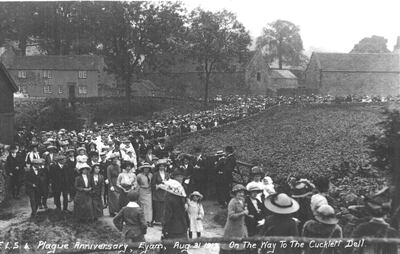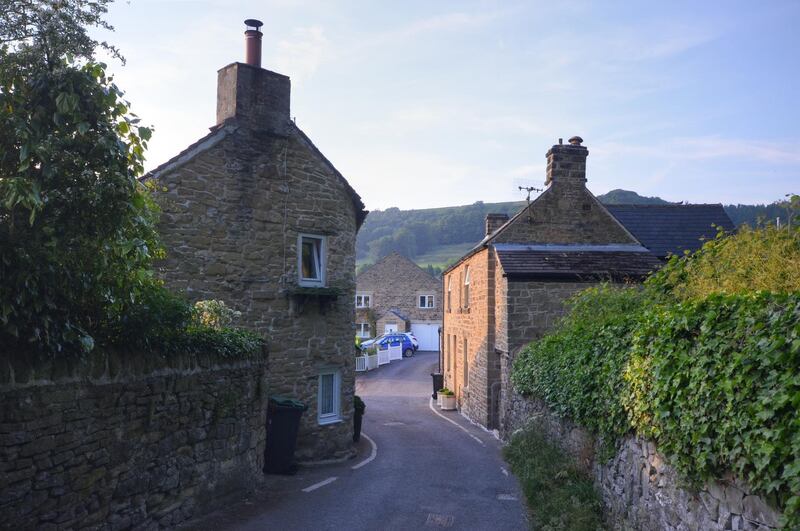In 1665, amid one of the last major outbreaks of the plague, a merchant returned from London to an isolated village in Derbyshire Dales called Eyam. The cloths he carried were most likely infested with the bacteria-carrying fleas that spread the bubonic plague – the intermittent scourge that had laid waste to Europe for the three centuries since the Black Death. But instead of the disease creeping onwards to the surrounding towns and cities of the north – Buxton, Manchester, Sheffield – it stayed confined to Eyam because the small village self-isolated.
For 14 months, from September 1665 to November 1666, the village cut itself off from the outside world. No one was allowed in or out, and all residents stayed inside their own homes – a situation that might feel familiar today. Food and medical supplies were passed on to the inhabitants by nearby villagers, who would leave them near the boundary stones at the edges of the village. After they had left, the inhabitants of Eyam would then venture out and fetch them. When they had the money to do so, they would leave coins for the goods, dropped into holes bored into the stones that were filled with vinegar, which was believed to kill the plague.
“It was a voluntary quarantine,” says Francine Clifford, a former schoolteacher who has become the town’s historian. “The people were a very faithful flock, and believed it was their Christian duty to protect those outside Eyam from getting the plague. They agreed to the measures, even though they were really signing their death warrant. They thought they’d all get it.”
Entire families were wiped out, across households: mothers went to help one daughter with her children, then returned to other children and passed on the sickness. A third of the village of 750 people died, a death rate of about twice that in London, where it was 17 per cent. “They paid the price, but they saved thousands of lives from villages and towns [nearby],” says Clifford.
The plan for Eyam was drawn up by reverend William Mompesson, a pastor for the Church of England who had been at his post in the town for only a few months when the plague struck. This bout of plague came on the heels of the English Civil War, a religious conflict, and he had been deputised to return the established church to Eyam, which had formerly been served by the Puritan pastor reverend Thomas Stanley. Despite their differences in belief, Mompesson and Stanley worked together to institute a plan that was far-sighted in its understanding of disease transmission. Crucially, they limited cross-infection within the village both by quarantine and by what we would now call social distancing: villagers were instructed to keep at least 12 feet (3.6 metres) away from each other.
In practice, this meant banning both church services and funerals, which had serious consequences on the people’s belief system. “Closing the church was a big thing for them because the services and prayer were their only way of salvation,” says Clifford. “The villagers thought plague was a God-sent punishment for sins that they’d committed – that it was a cloud in the heavens. If you’d been very sinful, God would send the cloud down and you would breathe in the miasma – the bad air. So the only way they thought they could avoid getting the plague was by prayer and repentance.”

Church services ended up being held outside, with households standing 3.6 metres apart, but funerals were prohibited entirely. The typical practice in those days was a procession through the town, with villagers following what would have been the infected body on its way to the local graveyard. During the period of self-isolation, all households had to bury their dead in their gardens or fields. “They were horrified,” says Clifford. “But they agreed.”
Clifford describes herself as a "newcomer" to Eyam, having moved there 36 years ago, from Sheffield, 20 kilometres away. She and her late husband, John, were both schoolteachers, and took on the role of town historians, co-founding the popular Eyam Museum and researching Victorian-era accounts by going through local government and church registers. Eyam's sacrifices were as well known in the area then as they are today. A local nobleman, the Earl of Devonshire, donated food to the village, being inspired by its "brave resolve" – as a London newspaper put it, reporting on the events in 1665. A number of books, plays and paintings have drawn on Eyam's story, and researchers into infectious diseases such as Ebola have looked to the village as a case study for effective quarantine measures.
The pair found that many of the stories had been romanticised – and that the real stories were often equally as heartbreaking. One tale involves the Siddalls, a family that was almost entirely wiped out because of one member who met her lover in secret. The Victorian account has the mother of the family, the sole survivor, going mad and living like a wild woman on the moors.
In reality, Elizabeth Siddall lived and remarried a fellow plague widower – a marriage that did not last long. He too died of the plague, and she followed within a few months. On her deathbed, she entrusted the care of her son to another family who themselves had lost eight children. The scrap of paper on which she scrawled this last will and testament had been lost to history, before Clifford and her husband found it.
Clifford, herself, is a testament to the stoicism associated with northern England. At 85 years of age, she compares this pandemic to the Second World War. “I was evacuated two or three times from London. That was almost better because you knew if it got bad, you had somewhere to go.” And she says she accepts help from her neighbours only because she would not want to pass on the coronavirus herself, should she become sick.
“What happened to us in the past is virtually being repeated now,” she says. “People putting themselves at risk to save the greater community. For someone as old as me, it is quite overwhelming, the care and the love that’s going around in the community. I wonder if Eyam feels we have to maintain the same community spirit we had 350 years ago.”
Clifford adds that life goes on. She became a great-grandmother on the first day of the UK lockdown, although she has, of course, yet to see the baby.







